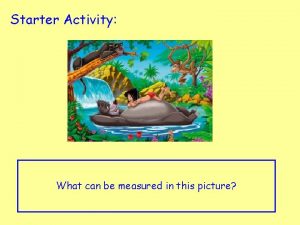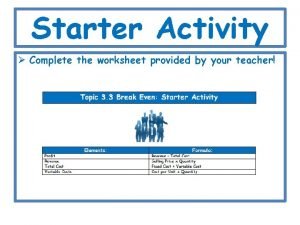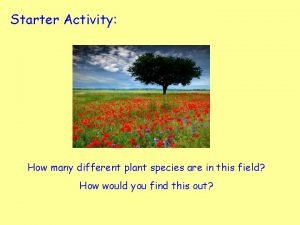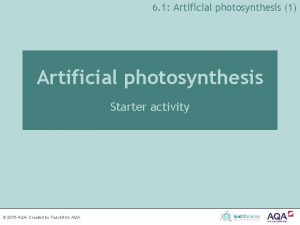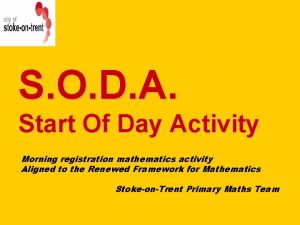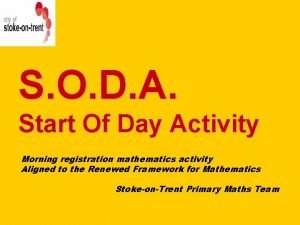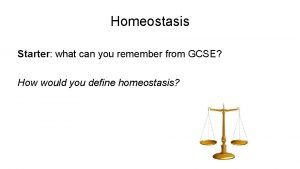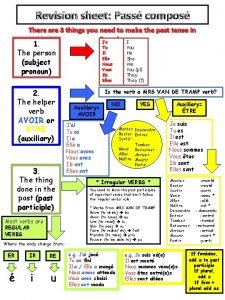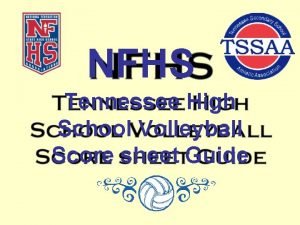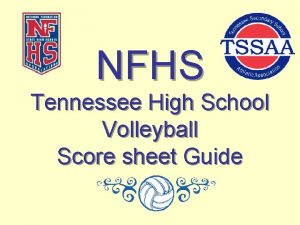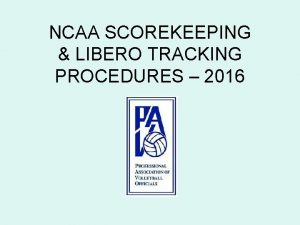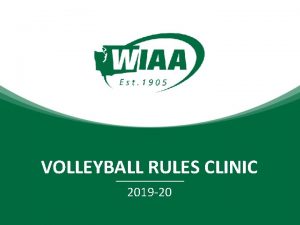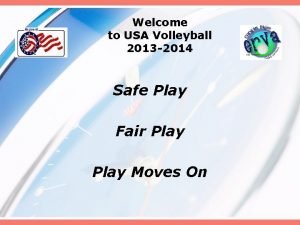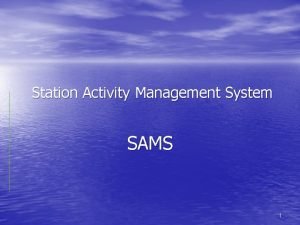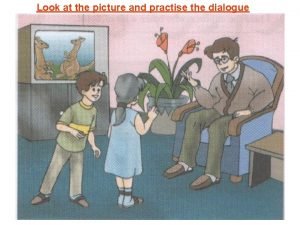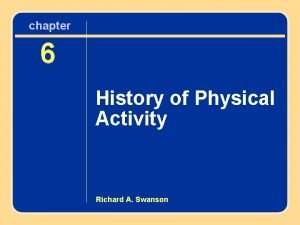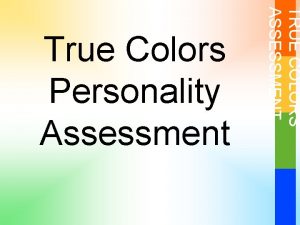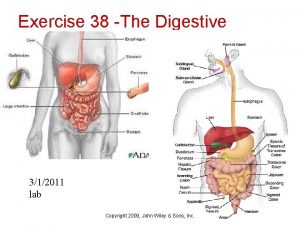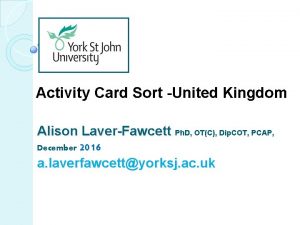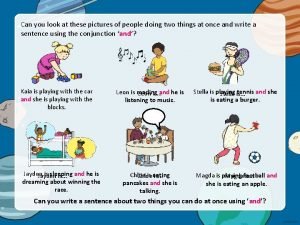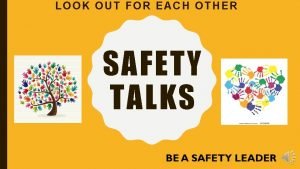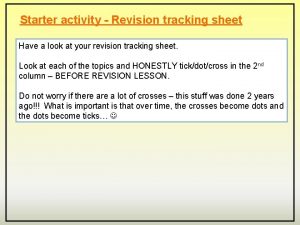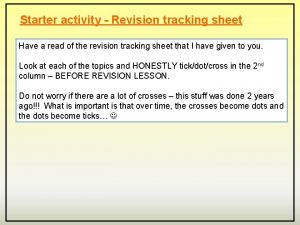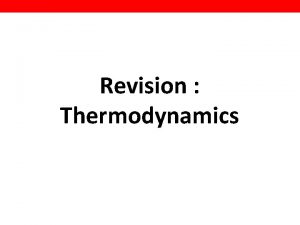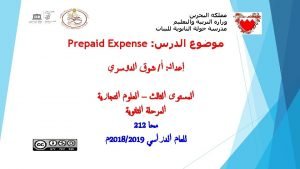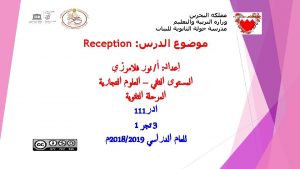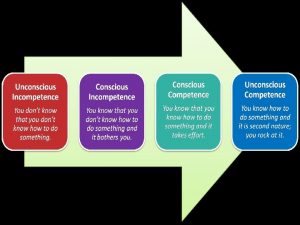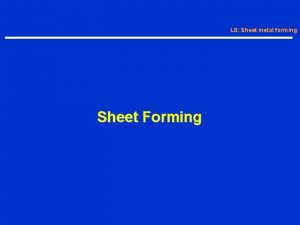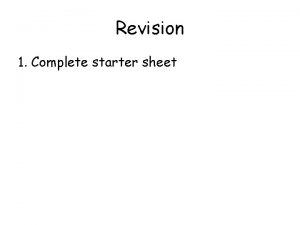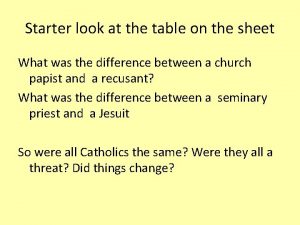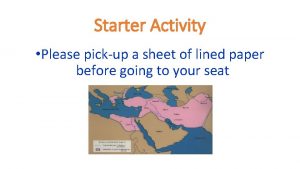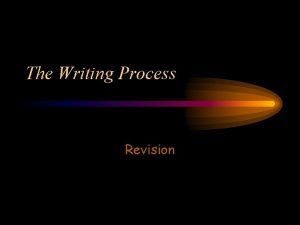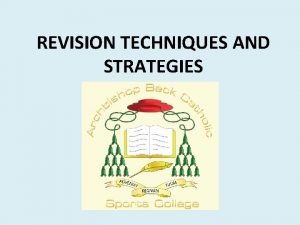Starter activity Revision tracking sheet Have a look











































- Slides: 43

Starter activity - Revision tracking sheet Have a look at your revision tracking sheet. Look at each of the topics and HONESTLY tick/dot/cross in the 2 nd column – BEFORE REVISION LESSON. Do not worry if there a lot of crosses – this stuff was done 2 years ago!!! What is important is that over time, the crosses become dots and the dots become ticks…

The cardio-respiratory system What do you remember? Just like Musculo-Skeletal system were a mixture of the SKELETAL and MUSCULAR systems, what 2 systems do you think make this one up? 1. Cardio Vascular System 2. Respiratory System But what is each of these? Let’s start with the Cardiovascular system…

Components of the CVS Task: Can you remember what the cardiovascular system is? What do you think it is made up of? Do you know what CARDIO and VASCULAR mean? 1. HEART 2. BLOOD VESSELS

The cardiovascular system Learning goals • To know the components of the heart. • To know the differences between veins, arteries and capillaries. • To know the pathway of blood through the body • To know how to define the terms heart rate, cardiac output and stroke volume.

The heart Can you remember, what type of muscle is the heart? Cardiac muscle

The heart – What can we remember about it?



Chambers of the heart RIGHT ATRIUM An upper chamber receiving deoxygenated blood RIGHT VENTRICLE A lower chamber containing deoxygenated blood What do you remember? LEFT ATRIUM An upper chamber receiving oxygenated blood from the lungs LEFT VENTRICLE A lower chamber containing oxygenated blood

The heart – What can we notice about it?

Blood vessels What do you remember? ‘Vessel’ means something that carries something – so blood vessels are things that ‘carry’ blood. For blood to get either into or out of the heart and around the body, it travels in BLOOD VESSELS. There are 3 main types of blood vessel. Do you remember what they are…? • Arteries • Veins • Capillaries Do you remember the differences between them?

Arteries (AA) What do you remember? Arteries transport blood away from the heart (from the ventricles) Small lumen They are coloured because they usually carry OXYGENATED blood that is ‘oxygen rich’ Arteries carry blood under a high pressure – why do you think this is? Discuss it with a partner Thick walls

Veins (TV) What do you remember? Veins transport blood from all over the body back to the heart (into the atriums) They are coloured blue because they usually carry DEOXYGENATED blood that is full of waste products, and are low in oxygen. Veins carry blood under a low pressure – do you think that you now know why? Thin walls Large lumen

Veins… An unique feature of veins is that they have valves. Like the valves in the heart, they are there to prevent a backflow of blood. The blood must flow in one direction only, against gravity in most cases, back to the heart. Why do you think it is important that veins have valves but arteries don’t? Remember = Veins have Valves

Differences between types of blood vessels Arteries Veins Take blood away from the heart (from the ventricles) Take blood to the heart (into the atriums) Walls are thick and elastic Walls are thin Usually transports oxygenated blood Usually transports deoxygenated blood Small lumen Large lumen Has a strong pulse and blood travels in spurts Has weak pulse and blood travels smoothly Have no valves Veins have valves

Capillaries – remember these…? What do you remember? Capillaries are small and thin blood vessels that carries blood to and from the body’s cells. They are one cell thick They are the exchange points where oxygen and carbon dioxide cross into the blood stream from the alveoli p. s - Don’t worry about this too much now – we’ll look at it in more detail later! The wall is only one cell thick

The 4 main blood What do you remember? vessels Pulmonary artery. Carries deoxygenated blood from the heart to the lungs. Aorta. Oxygenated blood is pumped at high pressure from the heart to the muscles Vena Cava Returns deoxygenated blood from the muscles to the heart. Pulmonary vein. Returns oxygenated blood from the lungs to the heart.

Pathway of blood through the What bodydo you remember? Right Atrium Right Ventricle Muscles Pulmonary Artery Aorta Lungs Left Ventricle Left Atrium Pulmonary Vein

Redistribution of blood during exercise The body uses two mechanisms to control the redistribution of blood: Vasoconstriction and Vasodilation What do you remember? During exercise, blood flow to muscles increases to meet the increase in oxygen demand. This redirection of blood flow to the areas where it is most needed is known as a vascular shunt.

What is heart rate? “The number of beats that your heart does per minute” Resting heart rate An ‘average’ person’s RHR is about bpm The cardiac muscle in a trained athlete is larger and stronger. Each beat forces out a larger amount of blood than a normal heart. It therefore takes less beats in a minute to supply the body with enough oxygen. Can you remember what happens to heart rate during exercise and why? Do you remember what anticipatory rise is?

Stroke volume and cardiac output SV and CO are also very good indicators of how efficient our CS is. What do you remember about SV and CO (Q)? Stroke volume is the amount of blood pumped out of the left ventricle per beat. Cardiac output (Q) is the amount of blood pumped out of the left ventricle of the heart per minute. Cardiac output can be calculated by multiplying the stroke volume by the heart rate: cardiac output (Q) = stroke volume × heart rate As you get fitter, what happens to your RHR and SV? Why?

Effects of exercise on the cardiovascular system What do you remember about IMMEDIATE effects? 1. Immediate (during exercise) • To keep the body supplied with what it needs, the heart beats faster and with greater force • Heart rate increases • Cardiac Output increases • Blood pressure increases • Blood is moved from where it is needed least to where the action is. (eg. away from organs to working muscles) – vascular shunt • Blood vessels widen and narrow at different points – vasocon/di • The exercise generates heat, so blood moves to the skin to cool down. This causes the skin to go red and sweat which cools you by evaporation. This is called Thermoregulation • The heat that is produced through muscle contraction raises the core body temperature which causes fatigue.

Effects of exercise on the cardiovascular system What do you remember about LONG TERM effects? 2. Long term (months and years of regular exercise) • The heart gets bigger and stronger. This is called HYPERTROPHY • Stroke volume increases as the chambers of the heart are larger so can fit in more blood with each beat • As the heart becomes more efficient your resting heart rate decreases. This is called BRADYCARDIA

Phew – breathe!!! That is the first half of topic 1. 2 – Cardiovascular system recapped. You now need to do a few things… 1. Tick/dot/cross the ‘after revision lesson’ column for each topic covered today. 2. Make sure that before next lesson you have completed the revision cards for those topics and you have ticked the correct column to say that you have made all of the cards. 3. Re read your notes in detail for any of the topics that you put as crosses.

Starter activity - Revision tracking sheet Have a look at your revision tracking sheet. Look at each of the topics and HONESTLY tick/dot/cross in the 2 nd column – BEFORE REVISION LESSON. Do not worry if there a lot of crosses – this stuff was done 2 years ago!!! What is important is that over time, the crosses become dots and the dots become ticks…

The Respiratory system Learning goals • To know the structure of the respiratory system and the pathway of air. • To know how to describe the process of GASEOUS EXCHANGE • To know the mechanisms of breathing. • To know some important breathing volumes. • To know how to label and interpret a spirometer trace. • To know some of the effects of exercise on the respiratory system

Components of the RS What do you remember about what the respiratory system is? What does it consist of? What is it all about? 1. Lungs 2. Breathing (pathway of air)

Understanding the structure of theyou. RS Can remember what the parts of the RS are? BRONCHIOLES RIBS ALVEOLI DIAPHRAGM NASAL CAVITY INTERCOSTAL MUSCLES BRONCHI TRACHEA LARYNX

The function of the Respiratory System There is one main function of the RS – can you remember what it is? To provide the opportunity for GASEOUS EXCHANGE What do you remember?

Gaseous exchange takes place in the alveoli. The alveoli are tiny air sacks inside the lungs. They are only 1 cell thick When you breathe in, they fill with air. The alveoli are covered in tiny capillaries (the smallest blood vessels). Gases can pass through the thin walls and travel into the blood stream. Oxygen and CO 2 swap (or EXCHANGE) place With training this process of gaseous exchange becomes more efficient and therefore improves performance.

Assisting Gaseous exchange Everyone (especially athletes) would like to have a really efficient gaseous exchange. 1. Alveoli having a large surface area. This means trying to keep them clean and not covered in tar… 2. Capillaries have moist thin walls (one cell thick). This promotes quick diffusion. 3. Capillaries very near to alveoli, so diffusion distance is very short. 4. There are lots of capillaries. This means lots of chance to smother the alveoli 5. A large blood supply. An increased red blood cell content increases the amount of oxygen supplied to muscles and other body tissues. 6. Gases will always move from areas where there is more of it, to areas where there is less of it. So they will always move from areas of high concentration to areas of a low concentration. This means that Oxygen and CO 2 will naturally ‘want’ to swap places

Haemoglobin… What do you remember? HAEMOGLOBIN is carried in red blood cells Oxygen combines with the red blood cells to form: OXY-HAEMOGLOBIN. Haemoglobin also transports carbon dioxide back from the tissues to the lungs.

The mechanics of breathing Do you remember the difference between the following…? INSPIRATION EXPIRATION

The mechanics of breathing Breathing is the first stage in supplying oxygen to our body cells. When breathing in (inspiration): The intercostal muscles contract, lifting the ribs upwards and outwards causing the to chest expand. The diaphragm contracts. It pulls down and flattens out the floor of the rib cage. The lungs increase in size as the chest expands. The pressure inside our lungs falls as they expand. The higher pressure of air outside means air (inc Oxygen) is now sucked into the lungs through the nose and mouth.

The mechanics of breathing When breathing out (expiration): The intercostal muscles relax. The ribs move downwards and inwards under their own weight. The chest gets smaller. The diaphragm relaxes. It is pushed back into a domed position by the organs underneath it. The lungs decrease in size as the chest gets smaller. They are squeezed by the ribs and diaphragm. The pressure inside the lungs increases as they get smaller. The air pressure outside is now lower than in our lungs. Air (inc CO 2) is forced out of the lungs through the nose and mouth.

The mechanics of breathing (Grade 7 -9) The lungs can expand more during inspiration due to the use of the pectoral muscles and sternocleidomastoid in the neck. During expiration this aid is provided by the abdominals.

Breathing volumes to remember Just as when we looked at the cardio vascular system and we had to remember cardiac output, stroke volume and heart rate, there a few breathing volumes that we also needed to know: What do you remember? • Tidal volume • Inspiratory reserve volume • Expiratory reserve volume • Residual volume From their names do you think you could remember what any of them mean?

Tidal Volume The volume of air inspired or expired per ‘normal’ or non forced breath. Inspiratory Reserve Volume The volume able to be forcibly inspired during normal breathing Expiratory Reserve Volume The volume able to forcibly expired, after a normal breath. Residual Volume The volume of air that remains in the lungs after forced maximum expiration.

Interpretation of a spirometer trace (USE OF DATA) Inspiratory Reserve Volume Residual Volume Expiratory Reserve Volume Which red arrow is which volume? ? ? Tidal Volume

Breathing volumes… Can you remember what happens to each of the volumes when you start to exercise? Answer each one as they are not all the same! Increase Decrease Tidal Volume Inspiratory Reserve Volume Expiratory Reserve Volume Residual Volume Bonus Task: Grade 7 -9 Can you tell me WHY? ? ? No Change

Effects of exercise on the respiratory system What do you remember about IMMEDIATE effects? 1. Immediate (during exercise) • • Breathing rate (frequency) increases Tidal volume (depth) increases IRV and ERV decrease due to the larger TV May feel light headed as oxygen struggling to get to brain and other organs as it goes to working muscles • This could lead to nausea (feeling sick)

Effects of exercise on the respiratory system What do you remember about LONG TERM effects? 2. Long term (months and years of regular exercise) • Lungs increase in size • Lungs and blood vessels become more efficient at working together • Gaseous exchange is more efficient • Overall stamina/cardio vascular endurance will be improved as you are not having to try as hard to get a supply of oxygen to the muscles

Phew – breathe!!! That is all of topic 1. 2 – Cardio Respiratory system recapped You now need to do a few things… 1. Tick/dot/cross the ‘after revision lesson’ column for each topic covered today. 2. Make sure that before next lesson you have completed the revision cards for those topics and you have ticked the correct column to say that you have made all of the cards. 3. Re read your notes in detail for any of the topics that you put as crosses. 4. Revise everything – in a few lessons time, you will be completing some test questions on these topics.
 Look up look down
Look up look down Look at activity 1 and answer
Look at activity 1 and answer Activity 1 picture analysis
Activity 1 picture analysis Activity 1 a) look at the picture
Activity 1 a) look at the picture Passive sentence
Passive sentence Abiotic factors clipart
Abiotic factors clipart Starter activity
Starter activity Paired statement keys
Paired statement keys Photosynthesis starter activity
Photosynthesis starter activity Starter of the day activity soda morning soft start
Starter of the day activity soda morning soft start Starter of the day activity soda morning soft start
Starter of the day activity soda morning soft start Homeostasis starter activity
Homeostasis starter activity Revision sheet
Revision sheet Student data tracking
Student data tracking Ihsaa volleyball score sheet
Ihsaa volleyball score sheet Nfhs lineup sheets for volleyball
Nfhs lineup sheets for volleyball Fhsaa volleyball score sheet tutorial
Fhsaa volleyball score sheet tutorial Umassd electrical engineering flowchart
Umassd electrical engineering flowchart Ncaa volleyball score sheets
Ncaa volleyball score sheets Wiaa volleyball warm up time
Wiaa volleyball warm up time Wpi ece flowchart
Wpi ece flowchart Usa volleyball libero tracking sheet
Usa volleyball libero tracking sheet Mcfrs iecs
Mcfrs iecs Is a prism having six square faces 12 edges and 8 vertices
Is a prism having six square faces 12 edges and 8 vertices Stock verification sheet is also known as
Stock verification sheet is also known as Practise this dialogue with your friend
Practise this dialogue with your friend Between 1950 and 2000, physical activity professions
Between 1950 and 2000, physical activity professions True colors activity sheet
True colors activity sheet Activity sheet 2: stock market calculations
Activity sheet 2: stock market calculations Activity sheet 3 a tale of two chocolate companies
Activity sheet 3 a tale of two chocolate companies Activity sheet 1 reading a stock quote
Activity sheet 1 reading a stock quote Exercise 38 review sheet art-labeling activity 1 (2 of 2)
Exercise 38 review sheet art-labeling activity 1 (2 of 2) Activity card sort assessment
Activity card sort assessment Exercise of adverb
Exercise of adverb Reactants, products, and leftovers
Reactants, products, and leftovers Activity coefficient
Activity coefficient Aoa in project management
Aoa in project management Activity 1 introductory activity
Activity 1 introductory activity Activity 2 finding the sequence
Activity 2 finding the sequence Activity 2 finding the sequence
Activity 2 finding the sequence Activity 1 activity 2
Activity 1 activity 2 Look at the picture.say and guess
Look at the picture.say and guess Pictures of
Pictures of Look out for each other
Look out for each other





